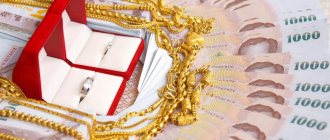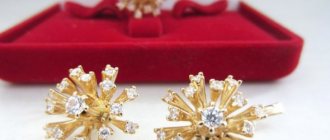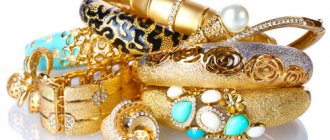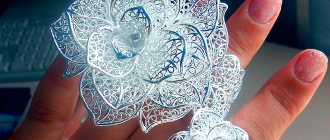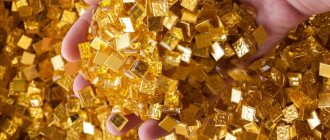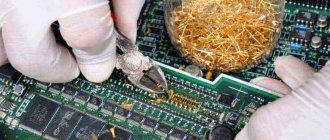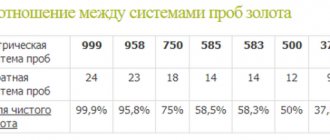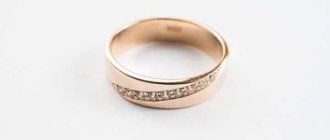History of silver
Silver is a precious metal that, along with gold, has been considered a symbol of prestige and high social status for many centuries. It was known to our ancestors back in prehistoric times.
Natural deposits of silver are extremely rare, so until the 2nd millennium BC. this metal was valued twice as much as gold
In ancient Babylon and Assyria, silver jewelry was given sacred meaning, and the metal itself was a symbol of the Moon. In the 18th century, silver began to be used to make dishes and household items, which for a long time were available only to members of the nobility and high society. Many countries still use silver to mint coins.
Interesting facts about silver
Welcome to the website Interessno.ru, dear readers. Silver is a popular metal that is most commonly used in jewelry. Of course, it is inferior in value to gold (if we talk about jewelry), but it is still in great demand due to its low cost.
In its pure form, it is too soft, so sterling silver, an alloy of 92.5% silver and 7.5% copper (often another metal is added instead of copper), is most often used in jewelry and tableware.
But what else do we know about this metal? Actually, not so much. So today we decided to fix it. We have prepared the most interesting facts about silver especially for you. We hope that the information from this article will be useful not only for children and schoolchildren, but also for adults.
Since it has antibacterial properties, it has been used for medicinal purposes since ancient Greece. The ancient Greeks and Romans used this metal to prevent infection, and the stability of the Roman economy depended on the supply of this metal, which was mined at a rate of 200 tons per year.
In the Middle Ages, its antibacterial properties were also used to disinfect water and protect food during long-term storage.
They started mining it a long time ago. The first evidence of mining this metal dates back to 3000 BC. For the first time, mining of this metal began in the territory of modern Turkey and Greece. Ancient people even learned to separate silver from other metals. They smelted the ore and then blew air over it. This process is called cupellation. The noble metal does not react to oxygen, while copper and lead are oxidized and separated from the silver.
It conducts electricity better than any other existing metal. In fact, silver is the standard from which other conductors are measured. On a scale from 0 to 100 for conductivity, silver ranks 1st (scores 100 points). Copper comes in second place, followed by gold, aluminum and magnesium.
Silver nuggets are still found in nature, but very rarely. Almost all silver produced is a by-product of the mining of other elements such as sulfur, lead, copper, etc.
It is a very ductile metal. Just 28 grams is enough to create a thread 2450 meters long. In addition, a silver “grain” weighing about 65 mg can be rolled into a sheet that will be the same size as a sheet of paper, but thinner (about 150 times).
You may have once heard the name “German silver”, also known as cupronickel. No. This is not some super test. On the contrary, cupronickel does not contain this noble metal at all. This is a popular alloy of copper and nickel (sometimes zinc), which is actively used in jewelry and decoration. This alloy is very similar in appearance to sterling silver, but does not tarnish and is more durable.
As with gold, silver is found in the human body. However, scientists still have not understood what role this element plays in our body.
The highest concentration of this metal is observed in the human brain (0.03 mg per 1 kg).
Together with food, a person consumes about 0.1 mg of Argentum daily. Quite a lot of silver is contained in egg yolk (approximately 0.2 mg per 100 grams). It is excreted from the body mainly with feces.
Being in nature
There are two types of deposits of this precious metal: 1. Silver deposits, which are 50% or more silver. 2. Complex deposits in which silver is present as an associated component in the composition of other ores and metals. They make up the main reserves of the precious metal - about 80%.
Silver in nature and its designation in the periodic table
Peru is considered the leader in silver production (3,600 tons per year), followed by Mexico (3,000 tons per year) and Russia (2,500 tons). Also, deposits of this metal are actively being developed in China, Poland, Kazakhstan, Romania, and many other countries. Surprisingly, silver can also be found in native form. There are several impressive facts about the discovery of huge silver nuggets.
In 1477, a silver plate weighing 20 tons and about 30 m long was found in Canada at the Cobalt mine. The find was called the “Silver Pavement.” Another plate weighing 612 kg, found in the same mine, is currently stored in the Canadian government building
Silver is used all over the world.
2. The word silver comes from the ancient Indian “sarpa”. Sarpa was the name given to the Moon and the sickle, which got its name from the fact that it looks like the Moon.
3. Despite the fact that from time immemorial gold has been valued much higher than silver, it is silver that appears in a variety of cultures as a metal that is especially pure or has some special properties.
4. Silver is a much more common metal than gold, and much cheaper.
5. But silver has also been valued for its qualities since time immemorial, and, like gold, silver has been used for centuries as financial security.
SILVER JEWELRY
6. Now silver is actively used not only in jewelry, but also in industry.
7. Besides jewelry, silver is mainly used in the photo industry, long-life batteries and solar panels.
8. Sea water conducts electricity a hundred times better than fresh water, but even so, it is a million times worse as a conductor of electricity compared to silver.
9. There is about 10 times more silver dissolved in sea water than gold.
10. Almost every electrical appliance in our house contains silver.
11. Silver is number 47 in the periodic table and is called Argentum (Ag).
12. Silver is a white metal with a silvery sheen, malleable, easy to cut with a knife.
13. Its properties are thermal conductivity, electrical conductivity, luster and malleability.
14. The density of silver is 10.5, and the melting point is 960.5 degrees.
15. Silver has almost one hundred percent light reflectance (99%), so it is used to make mirrors and cameras.
16. People began to use silver even before our era. Silver began to be used already in the Bronze Age.
17.In Sardinia it was used in the Copper Age. There it has been mined and processed since the early Chalcolithic era. This became possible due to the fact that previously the noble metal could often be found in the form of nuggets, and it did not need to be smelted from other ores. Gold also occurs in the form of nuggets, but less frequently.
18. Silver is perhaps one of the most shrouded in an aura of mystery among other metals.
19. Myths and legends of many peoples of the world endow silver with mystical properties - the metal is supposedly capable of scaring away vampires, evil spirits and other evil spirits.
20. Silver plates have been used since ancient Egypt. They were applied to an open wound. It was believed that this could prevent suppuration and speed up the healing process. This treatment was effective because silver has bactericidal properties.
21. In ancient times, the Babylonians and Assyrians considered silver a symbol of the Moon and revered it as a sacred metal.
22. In Russia, silver was first smelted only at the end of the 17th century.
23. The largest nugget of white metal was found in the 15th century in the Ore Mountains. These mountains are located in Germany and the Czech Republic, the nugget was probably located in the German part of the mountains. The nugget had a mass of 20 tons and consisted of many nuggets fastened together.
24. In the Middle Ages, silver gained great popularity among alchemists. Then this metal began to be widely used for the manufacture of plates, kitchen utensils, cutlery and coinage.
25. In Rus', silver ingots, shaped like wooden blocks, were considered a measure of the value of any thing. If the price of an item was lower than a whole ingot, the bar was cut and the part that corresponded to the purchase price was taken. These parts of silver bars were called “rubles”.
26. Silver was once used in such an aspect of medicine as dentistry to treat toothache. For example, in Switzerland, a patient could put a silver coin in his mouth, and the pain was said to gradually go away.
27. Silver is an officially recognized food additive - it is designated as E174.
28. In India, many people believe in the healing properties of silver, and even eat it. For example, when decorating certain sweets, thin silver foil - warak - is often used. It is not only edible, but also useful due to its antibacterial properties.
29. Colloidal silver has been frequently used in folk medicine since the 1990s, although scientists have not come to a definitive conclusion regarding its properties.
30. Its biological role has not yet been sufficiently studied, but it is known that in the human body the most silver is contained in the neurons of the brain.
SILVER NUGGET
31. In Japan, silver is used in the production of air conditioners - such devices not only refresh, but also purify the air in the room.
32. Silver has the most curious ability to sterilize water. Moreover, a literally tiny amount is required - ten parts per billion.
33. Silver has antibacterial properties, and it can kill countless types of all kinds of bacteria.
34. The strong bactericidal properties of silver were used many centuries before bacteria themselves were discovered. This explains why silver coins are often found at the bottom of ancient wells.
35. Scientists conducted special studies and found that silver can increase hemoglobin levels and strengthen the human nervous system, relieve headaches and migraines, calm the nervous system and help overcome stress.
36. Another metal is named in honor of silver, which was discovered later, but is considered no less valuable today - if translated literally from Spanish, its name sounds “little silver”, this is platinum.
37. The word “silver” is translated from most languages of the world as “light” or “white”.
38. A person receives about 0.1 mg of silver daily from food. Egg yolk is especially rich in its compounds.
39. Small amounts of silver (about 0.02 milligrams per kilogram of weight) are found in the bodies of all mammals.
40. Silver salts are the safest substitute for chlorine in swimming pool water, and in the USA, athletes’ socks are even impregnated with silver so that their feet do not smell.
SILVER MINING
41. In the silver mines near the city of Potosí (Bolivia) in the 16th – 17th centuries, almost 1 billion pesos worth of silver was extracted. The peso was a coin that weighed about 20 grams.
42. The city of Potosi at the beginning of the 17th century had a population of 160 thousand people and was the largest city in America and the largest industrial center in the world.
43. The longest silver plate was found in Canada, its length was 30 meters! It was nicknamed the “silver sidewalk.” This plate consisted of many nuggets fastened together.
44. The world's largest silver nugget was discovered in the Middle Ages in Germany in the Saxon Schneeberg deposit. The precious block weighed almost 40 tons.
45. Despite all its beneficial properties, silver, like any heavy metal, has a toxic effect on the body when in excessive concentration. For example, silver ions can destroy DNA molecules and damage genes in sperm.
BLACKENING OF SILVER
46. When metal is exposed to the sun for a long time, it begins to fade and even turn black. This is because the air contains sulfur, which reacts with the silver, causing tarnish.
47.Silver jewelry is often coated with a thin layer of radium to protect the piece from loss of color and shine.
48. Interestingly, the human body also contains silver. It is concentrated in the brain, skin, adrenal glands and liver.
49. Argentina is named after silver. It is believed that a navigator from Italy met a sailor during his trip who told him that there was a country in which the mountains were entirely made of silver. The traveler went to this country, but of course he did not find any mountains made of metal. But a country where there is little of this white metal began to be called Argentina.
50. The largest reserves of silver are in India.
photo from the Internet
Chemical and physical properties
Silver is an incredibly malleable silvery-white metal that is heavier than copper but lighter than lead. Its density is 10.5 g/cm³. Over time, silver jewelry tarnishes: the metal reacts to hydrogen sulfide residues in the air. Thus, a sulfide coating with a characteristic pinkish tint forms on the surface of the product.
Treatment of silver with a special rhodium coating
Since the precious metal is very soft, an alloy of silver and other metals is usually used to make jewelry: copper, platinum, germanium, zinc and even silicon. In some cases, to give the product shine and strength, the jewelry is coated with a layer of rhodium. Rhodium is a durable silver-colored metal that is resistant to scratches and damage.
Records
- The largest metal nugget.
The largest nugget of white metal was found in the 15th century in the Ore Mountains. These mountains are located in Germany and the Czech Republic, the nugget was probably located in the German part of the mountains. The nugget had a mass of 20 tons and consisted of many nuggets fastened together.
- "Silver Sidewalk"
The longest silver plate was found in Canada, the length of which was 30 meters! It was nicknamed the “silver sidewalk.” This plate consisted of many nuggets fastened together.
- The richest country in silver.
The largest reserves of argentum are in India.
120 ton nugget, British Columbia
Application
In ancient times, it was believed that werewolves, vampires and other evil spirits were afraid of silver. Silver jewelry was used as a talisman and protection from evil forces. The healing properties of the metal have been known since ancient times. Thus, in ancient Egypt, doctors covered wounds with thin silver plates, and used silver dishes for long-term storage and disinfection of water. Research by modern scientists has shown that silver ions actually destroy harmful bacteria and microorganisms. A number of medications are also produced based on it. This metal is also used in the chemical industry as a catalyst. Silver is widely used in the production of electronics and batteries, tableware and, of course, jewelry.
Financial experts also note that in the context of the global economic crisis, silver is a profitable investment. The price of precious metals does not depend on the devaluation of the national currency and inflation.
Story
- When did you start using it?
Silver began to be used in the Bronze Age. In Sardinia it was used during the Copper Age. Silver is sometimes found in the form of nuggets and must be smelted from ores or other metals. In Russia, silver began to be mined on an industrial scale at the end of the seventeenth century.
- Use of silver in Ancient Egypt.
Silver plates have been used since ancient Egypt. They were applied to an open wound. It was believed that this could prevent suppuration and speed up the healing process. This treatment was effective because silver has bactericidal properties.
- The first currency in Rus'.
The first currency in Rus' was silver bars - hryvnias, which were cut into “rubles” if the cost of the goods was insignificant. It was difficult to divide the hryvnia into equal parts; one part came out longer, hence the phrase “chase a long ruble,” which means “to make a big profit by doing ordinary work.”
- Decline of the Ottoman Empire
The decline of the Ottoman Empire began in large part due to the flow of silver that the Spanish mined in Latin America. The value of this metal relative to gold fell tenfold, and the Ottoman economy, which was based on the silver coin “akçe,” suffered from this.
- The largest silver mine
Silver mines near the city of Potosi (Bolivia) produced almost 1 billion pesos worth of silver in the 16th and 17th centuries. The peso was a coin that weighed about 20 grams. The city of Potosi at the beginning of the 17th century had a population of 160 thousand people and was the largest city in America and the largest industrial center in the world.
City of Potosi
Silver in jewelry
The main use of silver is in the production of jewelry. Since metal in its pure form is not strong enough, alloys of silver and other materials are used to make jewelry. This is usually copper, which provides a sufficient degree of wear resistance. Gold, platinum, tin and zinc are also used. The process of joining metals is called “alloying”.
Rhodium silver jewelry with zirconium and topaz stones
In addition, an alloy of silver and cadmium is used to make luxury jewelry, which gives the product a unique shine and high strength. Due to the high cost of cadmium, such jewelry costs several times more than gold.
Who is silver jewelry suitable for?
I would like to say that everyone does, but this is not so. Some people are allergic to silver. More precisely, not on it, but on the metals contained in the alloy. Pure silver is hypoallergenic and cannot cause redness, burning or dizziness. But the impurities included in the decoration may well be so.
Here are some symptoms of an allergic reaction:
- Burning where the jewelry is worn;
- Redness of the skin;
- Itching or any other discomfort;
- Dizziness, rarely nausea;
- Headache.
If you notice at least one of the listed signs, try not wearing silver for one day and observe your condition. If the symptoms have passed, then you will have to stop wearing this jewelry, and choose the next silver items of higher quality and from trusted manufacturers.
Silver samples
The test mark on a piece of jewelry shows what percentage of silver is included in the alloy. There are 6 hallmarks of silver in Ukraine - 960, 925, 916, 875, 800 and 750. Each piece of jewelry must be stamped with a hallmark.
- The 960 standard contains 96% silver and an admixture of copper or platinum. 960 standard metal is used to make filigree items. Unfortunately, such jewelry is very delicate and easily deformed if handled carelessly.
- 925 standard contains 92.5% precious metal. In addition to copper, germanium, zinc and even silicon can be added to the alloy.
- The 916 standard contains 91.6% silver; this metal is used to make cutlery.
- The 875th sample is considered the most budget-friendly, containing only 87.5% silver. Often used to make jewelry and tableware. Products made from this metal are quite low in cost.
- 800 and 750 are used only for making silverware. The metal contains 80 and 75% silver. The rest is made up of impurities. Due to the high copper content, the alloy has a reddish tint and oxidizes quickly
Silver in life, everyday life and in the human body
This element has a very wide application in various fields: microelectronics, radio electronics, jewelry industry, medicine, cutlery production, art - and each industry has its own areas for using “Argentum”.
If we talk about everyday life, then most often we find cutlery and cutlery made of precious metals. It is already considered a good tradition to buy a small silver spoon for food for a newborn. It is used to make cufflinks, tie clips, ballpoint pens and much more.
Important! Did you know that the human body also contains argentum? It is necessary to regulate the oxygen content in the molar composition of the blood. But, if the amount exceeds the norm, then this becomes the cause of the development of argyrosis. This is a specific disease that has a number of interesting symptoms: the teeth become covered with a metallic patina, and the skin takes on a rich dark purple hue.
Caring for silver jewelry
To add shine, durability and strength, some silver jewelry is plated with rhodium. Usually, in such cases, you can find the letter P on the tag. Rhodium-plated silver does not need to be cleaned, it does not turn black and retains its shine throughout the entire period of use. The only negative is that the protective coating wears off over time, so it will need to be renewed at a jewelry workshop.
Silver jewelry that is not rhodium plated may darken over time and therefore requires careful care . Jewelry should be periodically cleaned using special solutions or dry tooth powder and a brush.
Cleaning silver jewelry at home
Many people mistakenly believe that silver jewelry is significantly inferior to gold jewelry in quality and prestige. But that's not true. Modern technologies for processing metals and precious stones allow designers to create real masterpieces of jewelry from silver, which are in no way inferior to gold jewelry.
Physically Backed Gold and Silver ETFs
The cheapest and most convenient way to find out the price of gold and silver is to use a physically backed ETF. For example, iShares Physical Gold (LON:SGLN) or (LON:IGLN), depending on whether you want to invest in GBP or USD, offers 'direct investment in gold' and held 225.18 tonnes at the end of March precious metal.
It is benchmarked against the LBMA gold price and has achieved an annualized return of 1.17% since its inception in April 2011, compared to 1.42% for the benchmark. Part of the reason for the lag is costs, although the total expense ratio (TER) is only 0.15% per year.
For silver bulls, there are funds such as iShares Physical Silver (LON:SSLN) or (LON:ISLN). It is benchmarked against the LBMA silver price and has produced an annualized loss of 5.41% since its launch in April 2011, compared to a 5.04% loss against the benchmark. As of the end of March, it contained 798.56 tons of metal.
Over the past 10 years, ETFs backed by physical gold have significantly outperformed their equivalent backed by physical silver, although both have followed the same general trend. Silver is the more volatile of the two, causing it to often be called the “devil metal,” but many believe it will perform well both as a hedge against inflation and due to growing demand for its use in solar panels.
The investment precious metal of these funds is owned by iShares Physical Metals plc, which issues debt securities against the value of the precious metal. The notes are only issued when the gold or silver is transferred to a designated vault account, which in this case is the JPMorgan vault in London.
In the unlikely event of default by the custodian, the metal held in the secured segregated account will be identified separately from the assets of the vault holder.
Physically backed ETFs have only been around for about 15 years, so they have not yet been tested in the event of a massive gold sell-off. No one knows for sure whether the market price of an ETF will be able to accurately track the value of the underlying asset in extremely volatile conditions if it experiences outflows on an unprecedented scale.
